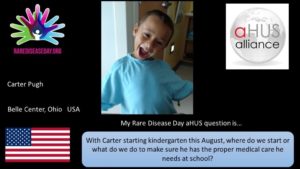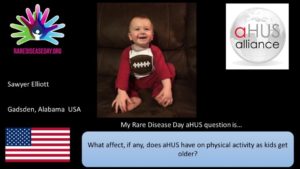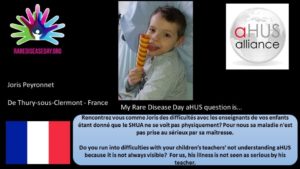Exploring your Questions, Rare Disease Day 2017
Children living with the rare disease atypical HUS are first and foremost children. Despite sharing common medical challenges with adult aHUS patients, it’s important to recognize that children have different developmental, environmental, and socio-emotional needs. Even with allowances for variations in age groups or among cultures, children often lack a voice in their medical care and the ability to express the ways in which aHUS impacts all areas of their young lives.
Parents and guardians, but also educators and medical providers, can make real and positive differences in both the daily life of children with aHUS and in their self-perceptions. Very young aHUS patients may still be developing language skills, which adds another layer to their care since infants or toddlers may be unable to express their needs, feelings, or wants in other than nonverbal communication. Some older children may find empowerment by having a voice in their treatment options and care plans, yet others may continue to feel overwhelmed after they learn that aHUS is a serious and lifelong medical condition. So what happens when children with aHUS are in a school setting? What’s on the minds of parents whose child is living with atypical HUS? The aHUS Alliance project for Rare Disease Day 2017 encouraged patients and caregivers around the world to submit questions. Here are some questions from entries related to children living with atypical HUS.
From Jayden’s family in St. Amant, Louisiana USA: “When will local infusion centers accept aHUS pediatric patients on Soliris?”

The answer largely depends on the patient’s location, and type of infusion centers available there. Services provided to young patients must consider staffing issues, with recruitment of medical personnel who are trained in pediatrics, in conjunction with aspects related to the facility and the equipment. The financial budgets of infusion centers treating pediatric patients would have to successfully accommodate purchases of a broader range of sizing in medical equipment (to include length- and weight-specific resources for emergency situations).
Most common are multi-specialty infusion centers, treating a variety of patient types such as oncology or hematology patients. Few studies have looked at patient preferences regarding infusion centers, but one 2014 study noted that the most important issue for patients was not the infusion center environment but the skill level of nurses administering and monitoring their infusion medications and process. “Almost 40% of infusions are performed at hospital-based centers, likely similar to ours. Additionally, for some US patients, their insurance carriers preferentially reimburse hospital-based infusion therapy over at-home self-injection, encouraging such individuals to have their biologic therapy administered at infusion centers.” (Ostrov et al, 2014). Some aHUS patients have reviewed local infusion options and decided to develop innovative solutions such home-based infusions or other personalized alternatives, decisions best made in partnership between the patient (or parent/guardian) and the patient’s medical care team.
Kindergarten is the start of a whole new world for children, and it’s an exciting time of learning and personal growth. Here’s a question from the family of Carter Pugh in Belle Center, Ohio USA. “With Carter starting kindergarten this August, where do we start or what do we do to make sure he has the proper medical care he needs at school?”

Start communications early with the school, and include all people likely to interact with your child such as: teachers, administrators, support staff, school counselors, main office staff, and especially the school nurse. Share facts and general information about the disease, and do clearly outline how your child’s medical situation may impact both learning and teaching. Review in detail your child’s specific medical needs and health history, which should include clear directions for any emergency situations that may occur during school hours or for particular situations of concern outside the classroom environment (such as gym classes or field trips). If you live in the USA, special education legislation provides clear paths within public schools to help guide and support a successful learning experience. In American public schools, parents can request a Pupil Evaluation Team (PET) meeting during, or even before the start of the child’s school year, for the school to discuss with parents possible options such as Individual Education Plans (IEPs) and 504 plans. There is a wealth of good general material online, but there are also specialized resources which have been created for parents on the topic of aHUS and education.
Atypical HUS presents very differently in people, so some families might have more concerns about learning-based issues while others might wish or need to focus on medical topics such as mobility, GI issues, blood pressure, central lines, or seizure history. Overall, children with atypical HUS will benefit from reduced viral and bacterial exposure during the school day. Just as in the workplace or with a childcare center, your child’s school should be able to provide information about their policies and protocols to prevent the spread of illness. Consider working with your child’s school to create an Individual Health Plan (IHP) that outlines simple adjustments such as using a personal caddy with the child’s own scissors, glue, and so on instead of utilizing shared classroom sets of materials handled by many small hands. School nurses have both medical training and in depth knowledge of the school setting, providing parents and students a valuable connecting point to share information while learning about access to services that promote both academic success and student health.
Know that there are wide variations in staffing and programming, with potential for great differences in services. Some parents feel educational impacts related to school size or geographic location, with others noting variations in whether their child attends classes in a private or public school setting. Especially for young students, include exploration of diverse aspects such as environmental, developmental, or sensory issues which have been noticed at home or mentioned at medical appointments. Early engagement with your child’s school is important to foster a team approach, so everyone can work together to address needs and concerns with a joint goal to maximize opportunities for a successful school year.
Here’s a related question from the family of Sawyer Elliot in Gadsden, Alabama USA. “What affect, if any, does aHUS have on physical activity as kids get older?”

Many parents and aHUS pediatric patients feel that limitations on physical activities are few, and social media is filled with photos of young (and not-so-young) atypical HUS patients beaming beautiful smiles in team photos and at individual sporting events. Atypical HUS is a complex disease, with no two cases alike in symptoms or severity, so each patient not only may have different sports abilities or restrictions but these may change over time and will be dependent on current health status.
Body organs and systems other than the kidneys may be affected by atypical HUS, to the extent that tiny clots (TMA) may occur anywhere blood flows (extra renal involvement). Some aHUS patients experience pulmonary (lung) issues which may present with asthma-like symptoms, other patients have central nervous system involvement (CNS) such as seizure activity or vision issues. Children with chronic renal disease (CKD or ESRD), especially those on dialysis, may experience growth issues or periods of fatigue. In 2015 there was an international consensus by researchers and clinicians regarding management of atypical HUS in children, which provides further information about medical guidelines.
Every patient is different, but most people feel their best when social, emotional, and physical factors are all taken into consideration within positive “can do” mental attitude. Communication and coordination among all involved can help with decisions regarding inclusion and range of physical activities, and with making the most of such opportunities. Most teams require a medical form or sports physical for children by or before middle school age, although some parents self-limit “impact” sports as a family preference if injury rates for that activity seem high. Parents and guardians need to be aware of maintaining the integrity of any central lines and ports, so check with your child’s medical team before enrolling your child in any sports program. While it’s important to recognize and accommodate physicians’ guidelines on physical activity, remember that movement and physical activity is important to overall health and can be both satisfying and joyful – at any age.
This question comes from the family of Joris Peyronnet in De Thury-sous-Clermont, France. “Do you run into difficulties with your children’s teachers’ not understanding aHUS because it is not always visible? For us, his illness is not seen as serious by his teacher.”

Yes, and know that adults in the workplace also have difficulty explaining the serious nature and the unpredictability of aHUS. Atypical HUS is a very rare disease, affecting only an estimated 1 or 2 patients per million, so few doctors or hospital staff will ever treat a child or adult with aHUS. Its rarity means this disease is not familiar to the general public, making it additionally difficult to relay our concerns about aHUS symptoms that may impact school performance such as fatigue or concentration issues that may accompany poor renal function. For those reasons and more, aHUS patients and caregivers find themselves on the ‘front lines’ of providing information and awareness about atypical HUS. While it’s obvious that children have needs beyond medical issues, people should understand that social and emotional challenges of rare disease impacts the entire family and ripples out to affect all areas of their lives.
Teachers have more experience in offering students support when seeing clear physical or outward signs of disease, such as a child in a wheelchair or with hair loss from cancer treatment. Many atypical HUS patients have no visible signs of disease, and physical signs of treatment such as dialysis fistulas, cannulas, central line tubes and dressings, or access ports usually remain somewhat hidden under skin or covered by clothing. School counselors may help teachers and other staff to better understand “invisible illness” issues that can impact a successful teaching-learning relationship for patients with atypical HUS. Providing your child’s school an array of educational materials can be a good first step to helping them understand that people with aHUS can experience sudden and severe symptoms, without prior warning signs.
Atypical HUS will be a life-long concern for patients of any age, given that it is caused by genetic changes in part of the immune system (the complement system), and that aHUS can affect a variety of body organs and systems. Consider printing and providing the one-page brief aHUS Facts sheet for teachers and also for administrators at your child’s school. As a more detailed and medically robust version, the aHUS Facts & Key Resources can provide the school nurse a full list of key aHUS research articles. There are some aHUS resources available outside medical research and aHUS patient groups, and such as an Alexion website that features downloads of aHUS patient materials for US audiences. We hope that organizations and groups will continue to promote aHUS research and educational assets, and additionally the aHUS Alliance encourages all stakeholders to expand their outreach and to make resources available in multiple languages. We urge you to connect and work together with other aHUS families in your nation, and also suggest you may find help and information when viewing resource lists provided by your country’s rare disease, renal, and genetic organizations as well.
Stay connected with the aHUS Alliance to keep current on aHUS news, information, and resources.
Follow us on Twitter: @aHUSallianceAct
Connect with us on Facebook: aHUS Alliance
Find More on our Website: www.aHUSallianceAction.org

